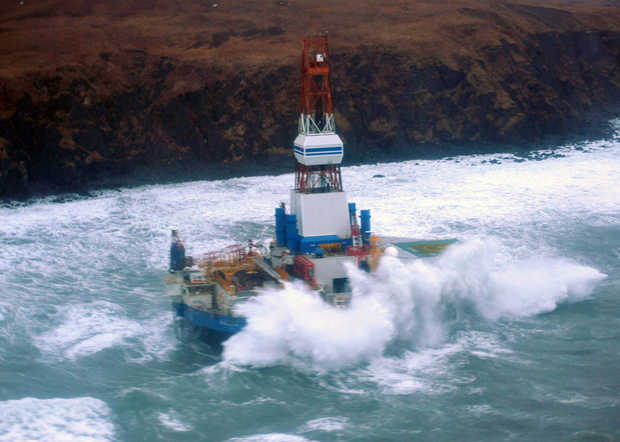Shell Oil has been doing test drilling in the Arctic off Alaska’s north shore and this week the reality of just how problematic this can be came to fruition. The Arctic is an extreme environment. And planning for all the potential things that can go wrong usually leaves out the one thing that does go wrong.
As I opened my morning newspaper today buried at the back of the first section was just the kind of story that environmentalists have been warning us about since oil exploration began in the Arctic. In September Shell Oil stopped prospecting in the Chukchi Sea with its rig, named Kulluk, because of equipment failures, and unexpected ice build ups. The operation to bring the rig south to a winter refit at a shipyard in the state of Washington required the use of tow ships. In weather described as horrendous, the rig broke free of its towing vessel, the Aiviq, which experienced repeated engine failures. A second emergency vessel, the Nanuq, attempted to re-establish a tow line but was unsuccessful in the stormy seas. The drifting rig eventually ran aground on the coast of Sitkalidak, an uninhabited island near the community of Old Harbor situated on Kodiak Island where there is a major Coast Guard station. The strait in which it ran aground is home to a threatened species of sea lion. The attempts to re-establish a tow line were hampered by winds of 70 knots and 15 meter (50 foot) waves. The 18-member skeleton crew (the rig in operation has as many as 130 on board) had to be removed by the U.S. Coast Guard before the rig broke free and ran aground.
The current problem is one of salvage and to ensure that the 541,000 liters (143,000 gallons) of diesel fuel and 45,000 liters (12,000 gallons) of hazardous lubricants on board remain there. The Kulluk at last report is upright and stable. But should it continue to be subject to rough pounding from ocean waves its hull could breach unleashing a chemical disaster.
The Kulluk is a rig rated to work in water depths of up to approximately 120 meters (400 feet) and capable of drilling to depths of greater than 6,000 meters (20,000 feet) below the ocean floor. Built by Mitsui and commissioned in 1983, its hull is ice-strengthened and when positioned for drilling has 12 anchor lines to keep it in place. It is also equipped with a survival anchor. With no propulsion system of its own the rig relies on tow vessels for propulsion. It is not certain after it broke away from the tow if the survival anchor was deployed. This if deployed may have stopped it from running aground. But we don’t know if the anchor was used or if it malfunctioned. In hindsight, choosing an unpowered rig incapable of navigating on its own in an environment known for rough sea conditions may have been a big mistake because ultimately a rig like this turns into a big floating piece of steel that when out of control can do a lot of damage.
This isn’t Shell’s first mishap in its Arctic deep water drilling venture in 2012. Thick ice delayed operations in the spring. Then an accident happened with a second drilling ship that nearly ran aground. When deploying an oil spill containment dome the operation failed during testing and the dome sustained considerable damage. And in September when finally Shell was ready to go, after one day it was forced to abandon its test well operation because of unusually heavy sea ice in the area.
The current operation to salvage the rig is being frustrated by high seas and Arctic darkness, just two of the natural challenges of the extreme polar environment at this time of year. Shell was being watched by other oil companies who were going to start their own operations based on Shell’s expected success. That apparently is not in the cards now and critics of Arctic oil exploration can point to Shell and say “We told you so.”
For Arctic oil exploration the Kulluk and other mishaps that Shell has experienced raise some questions:
- If the rig survives the grounding intact should it be used again for Arctic oil exploration or should Shell start over and commission a better and motorized rig?
- The rig ran aground near a large Coast Guard centre in the Alaskan islands. What if an accident like this happens again in a more remote location with no Coast Guard nearby? Is it worth the risk considering the potential environmental impact?
- The U.S. government in its pursuit to be self sufficient in energy before the end of the decade has laid bets on alternatives to Arctic oil and gas exploration including extensive onshore exploration where containment of spills is more manageable. Will the government suddenly realize that current technology is not meeting the standards needed for Arctic oil and gas exploration and withdraw its permits?









